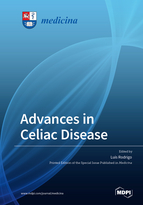Advances in Celiac Disease
A special issue of Medicina (ISSN 1648-9144).
Deadline for manuscript submissions: closed (30 June 2019) | Viewed by 50678
Special Issue Editor
Interests: celiac disease; gluten intolerance; Helicobacter pylori; gastrointestinal tumors; liver diseases
Special Issues, Collections and Topics in MDPI journals
Special Issue Information
Dear Colleagues,
Celiac disease is an autoimmune disorder induced by dietary gluten that affects to genetically predisposed individuals. It has a prevalence of 1–2% in many populations worldwide. New diagnoses have increased substantially in the last decades, due to increased awareness, better diagnostic tools, and probably, by a real increase in its incidence.
The list of recognized clinical presentations continues to expand, making the disorder highly relevant to all physicians. It is frequently associated along its evolution with a long spectrum of other diseases, mainly autoimmune in nature, that by one side ease its diagnosis and sometimes complicate its clinical evolution.
Newer diagnostic tools, including serologic tests for antibodies against tissue transglutaminase (tTG) and deamidated gliadin peptide, greatly facilitate the diagnosis. Tests for celiac-permissive HLA DQ2 and DQ8 molecules are useful in defined clinical situations. Celiac disease is diagnosed by histopathologic examination of duodenal biopsies. However, according to recent controversial guidelines, a diagnosis can be made without biopsy in certain circumstances, especially for children. Symptoms, mortality, and risk for malignancy can each be reduced by adherence to a gluten-free diet. This treatment is a challenge, however, as the diet is expensive, socially isolating, and not always is very effective in controlling symptoms or intestinal damage.
We would also like to encourage the submission of original manuscripts, communications, reviews, case reports aimed at providing a comprehensive overview of the recent advances in understanding celiac disease.
Prof. Dr. Luis Rodrigo
Guest Editor
Manuscript Submission Information
Manuscripts should be submitted online at www.mdpi.com by registering and logging in to this website. Once you are registered, click here to go to the submission form. Manuscripts can be submitted until the deadline. All submissions that pass pre-check are peer-reviewed. Accepted papers will be published continuously in the journal (as soon as accepted) and will be listed together on the special issue website. Research articles, review articles as well as short communications are invited. For planned papers, a title and short abstract (about 100 words) can be sent to the Editorial Office for announcement on this website.
Submitted manuscripts should not have been published previously, nor be under consideration for publication elsewhere (except conference proceedings papers). All manuscripts are thoroughly refereed through a single-blind peer-review process. A guide for authors and other relevant information for submission of manuscripts is available on the Instructions for Authors page. Medicina is an international peer-reviewed open access monthly journal published by MDPI.
Please visit the Instructions for Authors page before submitting a manuscript. The Article Processing Charge (APC) for publication in this open access journal is 1800 CHF (Swiss Francs). Submitted papers should be well formatted and use good English. Authors may use MDPI's English editing service prior to publication or during author revisions.
Keywords
- Celiac disease
- Epidemiology
- Autoimmune
- Diagnostic methods
- Serologic tests
- Genetic markers
- Immunology
- Pathogenesis
- Duodenal biopsy findings
- Associated conditions
- Non-celiac gluten sensitivity
- Gluten-free diet
- Long-term follow-up
- Refractory
- Intestinal Lymphoma
- Complications







